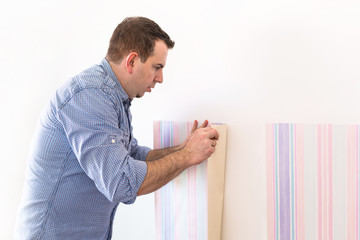When you’re ready to install a new wall covering, you need to follow a few basic steps. These steps will ensure that your new wallpaper looks its best. Here are some of them. Smooth the wallpaper out to make it look its best. If the wallpaper is too thick or thin, trim the excess with a sharp knife. Make sure to follow all instructions carefully. After all, you’re working on a big project!

The primary technique for putting Wallpaper Seattle is measuring, cutting, activating with water, and hanging. Remember to remove all debris and any mold or mildew from the wall when installing wallpaper. Mold or mildew can be harmful to your health. Depending on the type of wallpaper you want to use, the installation process varies. The most common wallpaper is prepasted, where the adhesive paste has already been applied to the back surface. On the other hand, unpasted wallpapers require you to wet the paste during installation.
Always measure the length of the wall. Be sure to overlap the baseboard and ceiling by at least 2 inches. Then, determine whether you’d like a random pattern, a straight line, or a drop match. Once you’ve chosen, apply the paste to the wall or the paper. After you use the paste, spread it evenly over the entire surface. Be sure to coat the back of the wallpaper with the paste evenly. When you’re done, gently fold the paper and allow it to sit for three minutes. This process is called “booking.”
After the wall is prepared, you should purchase wallpaper with instructions. Wallpapers that come with instructions are the easiest to install. You may even be able to peel and stick. Peel and stick wallpapers need separate glue, while prepasted papers need only water to stick them to the wall. Remember that some wallpapers can be repositioned. Follow the instructions carefully, and you should end up with a beautiful wallpapered room! If you’re unsure about how to install wallpaper, consult a professional!
When hiring a professional wallpaper installation service, make sure to research the different types of wallpaper. Find out how to choose the best materials and the type of adhesive to use for the wallpaper. It’s a big job, and a little research will help you avoid mistakes. You can always hire a professional to do the job if you get overwhelmed by the process. This will save you the stress and headaches of hanging your wallpaper.
The cost of wallpaper installation varies depending on the type and material used. The price of a single roll of wallpaper is about $25-$35, although you can often find great deals. Vinyl-coated wallpapers are cheaper than their fabric-coated counterparts. DIY installation is generally possible, but larger wallpaper projects require a professional. You may also need to hire a professional if you have problems with the paper, such as bubbles. Moreover, wallpaper can be challenging to clean, so you should consider hiring a professional if you plan to rent the room.
If you don’t want to hire a professional wallpaper installer, you can do it yourself. Wallpaper installation is a good option for DIYers because it will save you money on labor. The cost of wallpaper can range from $10 to several hundred dollars per roll. You will also need wallpaper installation tools, such as sponges, water trays, and paste. You’ll need to know the size of your walls. Once you’ve selected the wallpaper design, you can purchase the necessary tools for installation.
Before you begin, you need to remove all plug sockets and light switches. You’ll also need to remove the fascia around light switches and powerpoints. Once you’ve completed the process, lay the wallpaper over the top. Use a metal ruler or sharp knife to cut in the excess. Once you’re satisfied with the layout, let it dry for a few days at room temperature. Otherwise, the wallpaper may shrink. This will be a hassle if it’s not done correctly.
Here are a few things to consider before hiring a professional to install your new wall coverings. If you’re installing wallpaper in a large area, you’ll probably need to hire a professional, so keep these tips in mind. Remember that the cost of the job can add up over time, especially if you have extra-high ceilings or unusual patterns.